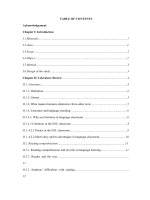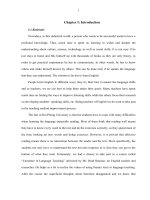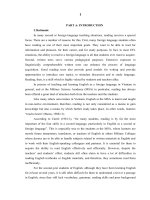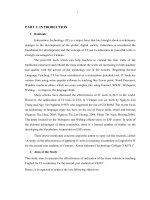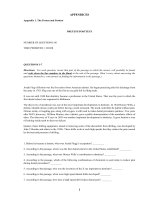Study on integrating listening speaking skills to enhance the speaking skills for second year undergraduate students
Bạn đang xem bản rút gọn của tài liệu. Xem và tải ngay bản đầy đủ của tài liệu tại đây (1.32 MB, 56 trang )
BỘ GIÁO DỤC VÀ ĐÀO TẠO
TRƯỜNG ĐẠI HỌC QUẢN LÝ VÀ CƠNG NGHỆ HẢI PHỊNG
-------------------------------
KHĨA LUẬN TỐT NGHIỆP
NGÀNH : NGƠN NGỮ ANH
Sinh viên
: Tô Cao Duy
Giảng viên hướng dẫn: ThS. Nguyễn Thị Quỳnh Hoa
HẢI PHÒNG – 2020
BỘ GIÁO DỤC VÀ ĐÀO TẠO
TRƯỜNG ĐẠI HỌC QUẢN LÝ VÀ CƠNG NGHỆ HẢI PHỊNG
-----------------------------------
STUDY ON INTEGRATING LISTENING-SPEAKING
SKILLS TO ENHANCE THE SPEAKING SKILLS FOR
SECOND YEAR UNDERGRADUATE STUDENTS
KHÓA LUẬN TỐT NGHIỆP ĐẠI HỌC HỆ CHÍNH QUY
NGÀNH : NGƠN NGỮ ANH
Sinh viên
: Tô Cao Duy
Giảng viên hướng dẫn: ThS. Nguyễn Thị Quỳnh Hoa
HẢI PHÒNG – 2020
BỘ GIÁO DỤC VÀ ĐÀO TẠO
TRƯỜNG ĐẠI HỌC QUẢN LÝ VÀ CƠNG NGHỆ HẢI PHỊNG
--------------------------------------
NHIỆM VỤ ĐỀ TÀI TỐT NGHIỆP
Sinh viên: Tô Cao Duy
Lớp
: NA1701
Ngành
: Ngôn ngữ Anh
Mã SV: 1312751068
Tên đề tài: Study on integrating listening-speaking skills to enhance the
speaking skills for second year undergraduate students
NHIỆM VỤ ĐỀ TÀI
1. Nội dung và các yêu cầu cần giải quyết trong nhiệm vụ đề tài tốt nghiệp
………………………………………………………………………………….
………………………………………………………………………………….
………………………………………………………………………………….
………………………………………………………………………………….
………………………………………………………………………………….
………………………………………………………………………………….
2. Các tài liệu, số liệu cần thiết
………………………………………………………………………………….
………………………………………………………………………………….
………………………………………………………………………………….
………………………………………………………………………………….
………………………………………………………………………………….
………………………………………………………………………………….
………………………………………………………………………………….
………………………………………………………………………………….
………………………………………………………………………………….
3. Địa điểm thực tập tốt nghiệp
………………………………………………………………………………….
CÁN BỘ HƯỚNG DẪN ĐỀ TÀI TỐT NGHIỆP
Họ và tên
: Nguyễn Thị Quỳnh Hoa
Học hàm, học vị
: Thạc Sĩ
Cơ quan công tác
: Trường Đại học Quản lý và Công nghệ Hải Phòng
Nội dung hướng dẫn: on integrating listening-speaking skills to enhance
the speaking skills for second year undergraduate students
Đề tài tốt nghiệp được giao ngày 03 tháng 08 năm 2020
Yêu cầu phải hoàn thành xong trước ngày 16 tháng 10 năm 2020
Đã nhận nhiệm vụ ĐTTN
Đã giao nhiệm vụ ĐTTN
Sinh viên
Giảng viên hướng dẫn
Hải Phòng, ngày tháng năm 2020
TRƯỞNG KHOA
CỘNG HÒA XÃ HỘI CHỦ NGHĨA VIỆT NAM
Độc lập - Tự do - Hạnh phúc
PHIẾU NHẬN XÉT CỦA GIẢNG VIÊN HƯỚNG DẪN TỐT NGHIỆP
Họ và tên giảng viên:
...................................................................................................
Đơn vị công tác:
........................................................................ ..........................
Họ và tên sinh viên:
.......................................... Chuyên ngành: ...............................
Nội dung hướng dẫn:
.......................................................... ........................................
.................................................................................................................................
1. Tinh thần thái độ của sinh viên trong quá trình làm đề tài tốt nghiệp
..............................................................................................................................................
........................... ..............................................................................................................................................
........................... ..............................................................................................................................................
........................... ..............................................................................................................................................
........................... ..............................................................................................................................................
........................... ..............................................................................................................................................
2. Đánh giá chất lượng của đồ án/khóa luận (so với nội dung yêu cầu đã đề ra
trong nhiệm vụ Đ.T. T.N trên các mặt lý luận, thực tiễn, tính tốn số liệu…)
........................... ..............................................................................................................................................
........................... ..............................................................................................................................................
........................... ..............................................................................................................................................
........................... ..............................................................................................................................................
........................... ..............................................................................................................................................
........................... ..............................................................................................................................................
........................... ..............................................................................................................................................
3. Ý kiến của giảng viên hướng dẫn tốt nghiệp
Được bảo vệ
Khơng được bảo vệ
Điểm hướng dẫn
Hải Phịng, ngày … tháng … năm ......
Giảng viên hướng dẫn
(Ký và ghi rõ họ tên)
QC20-B18
CỘNG HÒA XÃ HỘI CHỦ NGHĨA VIỆT NAM
Độc lập - Tự do - Hạnh phúc
PHIẾU NHẬN XÉT CỦA GIẢNG VIÊN CHẤM PHẢN BIỆN
Họ và tên giảng viên:
..............................................................................................
Đơn vị công tác:
........................................................................ .....................
Họ và tên sinh viên:
...................................... Chuyên ngành: ..............................
Đề tài tốt nghiệp:
......................................................................... ....................
.................................................................................................................................
.................................................................................................................................
1. Phần nhận xét của giáo viên chấm phản biện
.......................... ..........................................................................................................................................
.......................... ..........................................................................................................................................
.......................... ..........................................................................................................................................
.......................... ..........................................................................................................................................
.......................... ..........................................................................................................................................
.......................... ..........................................................................................................................................
.......................... ..........................................................................................................................................
2. Những mặt còn hạn chế
..........................................................................................................................................
.......................... ..........................................................................................................................................
.......................... ..........................................................................................................................................
.......................... ..........................................................................................................................................
.......................... ..........................................................................................................................................
.......................... ..........................................................................................................................................
.......................... ..........................................................................................................................................
3. Ý kiến của giảng viênchấm phản biện
Được bảo vệ
Không được bảo vệ
Điểm phản biện
Hải Phòng, ngày … tháng … năm ......
Giảng viênchấm phản biện
(Ký và ghi rõ họ tên)
QC20-B19
Table of content
Acknowledgment
Part 1: INTRODUCTION .................................................................................. 1
1. Rationale............................................................................................................ 1
2. Aim of the study ................................................................................................ 1
3. Scope of the study ............................................................................................. 2
4. Methods of the study ......................................................................................... 2
5. Design of the study ............................................................................................ 2
Part 2: DEVELOPMENT................................................................................... 3
CHAPTER 1: THEORETICAL BACKGROUND.......................................... 3
1. Definition of the listening skills...................................................................... 3
2. Types of listening .............................................................................................. 4
2.1. General Listening Types: ............................................................................. 4
2.2. Specific Listening Types ............................................................................. 6
3. Basic ways for students practice specific listening skills ................................. 8
3.1 Listen to your favorite subjects ....................................................................... 8
3.2 The audio materials suitable for your skills, levels ......................................... 9
3.3 Take not spelling, vocabulary and grammar ................................................. 10
3.4 Use transcripts of the materials you listened after practicing ....................... 11
4. Definition of the speaking skills ..................................................................... 11
4.1 Definition of speaking skills?........................................................................ 11
4.2. What is speaking skills? ............................................................................... 12
5. Types of speaking............................................................................................ 13
5.1. Form-focused speaking ................................................................................ 14
5.2. Meaning-focused speaking........................................................................... 14
5.3. Opportunities to improve fluency ................................................................ 14
6. Basic ways for students practice speaking English ......................................... 15
6.1. Improve your confidence ability before speaking ....................................... 15
6.2. Speak everywhere and every time................................................................ 15
6.3. Toning in speaking, stress in speaking English ........................................... 15
6.4. Learn phrases, not word for word ................................................................ 16
7. Relationship between speaking skills and listening skills in social
communication .................................................................................................... 16
CHAPTER 2: RESEARCH METHODOLOGY ........................................... 18
1. The participants ............................................................................................. 18
2. Survey questionnaire and data analysis .......................................................... 18
CHAPTER 3: FINDINGS AND DISCUSSION ............................................. 32
1. Conclusion .................................................................................................... 32
2. Solutions to improve listening skills ............................................................. 35
3. Solutions to improve speaking skills ............................................................ 36
4. Solutions to integrate listening and speaking skills at the same time........... 37
Part 3: CONCLUSION ..................................................................................... 38
1. Conclusion ....................................................................................................... 38
2. Suggestions from the study ............................................................................. 38
3. Limitations from the study .............................................................................. 42
REFERENCES .................................................................................................. 43
APPENDIX ........................................................................................................ 44
List of charts and tables
Chart 1: Best skills the students found at ............................................................ 18
Chart 2: The students found their most important skills .................................... 19
Chart 3: Answering whether they have heard about teaching methods of
integrating listening and speaking skills at the same time .................................. 20
Chart 4: Which learning methods the students applied to .................................. 21
Chart 5: Abilities of using speaking and listening skills - Haiphong private
university (20 students) ....................................................................................... 22
Chart 6: Abilities of using speaking and listening skills - Vietnam maritime
university (20 students) ....................................................................................... 23
Chart 7: Abilities of using speaking and listening skills - Haiphong university
(20 students) ........................................................................................................ 24
Chart 8: Abilities of using speaking and listening skills – Ace English center (20
students)............................................................................................................... 25
Chart 9: Abilities of using speaking and listening skills – Aten English center
(20 students) ........................................................................................................ 26
Chart 10: What techniques your English teachers were best at .......................... 27
Chart 11: Levels of interaction between students and teachers ......................... 28
Chart 13: The best ways the students found to learn English ............................. 30
Chart 12: The teaching methods the students felt about ..................................... 29
Table 1: Speaking skills of the students when they started learning English ..... 31
Table 2: General look at each place teaching English ....................................... 33
Table 3: General opinions of the students towards their learning methods ....... 34
Acknowledgment
My graduation paper could not have been completed without a huge
contribution of Ms Nguyen Thi Quynh Hoa, my supervisor, who gave me
valuable instructions, ideas, advice, as well as materials. Therefore, many of my
gratitude for Ms Quynh Hoa, what you have believed in my ability to finish this
adventure. I would like to thank Haiphong Management and Technology
University for giving me a very important opportunity to have such a special
journey in this environment. This school taught me a lot of things, when I was
only a little boy with not much knowledge in my life. And last but not least, I
also would like to thank all my family members, who always believe in me,
support me to do this job, always create the best quality furniture, and
atmosphere so as to keep me concentrated on this final task.
Hai Phong
To Cao Duy
Part 1: INTRODUCTION
1. Rationale
English has long been a common language of the world, just using English you
can communicate with more than 1.5 billion people on this planet. English is
used everywhere, from everyday life such as communication, movies, music ...
to international business, conferences and organizations all use English for
exchange. According to the trend of globalization, it is impossible not to master
English.
Vietnam is aware of this and also promotes and encourages people to learn
English, and the curriculum at all levels has English as the main subject. A lot of
English learners probably have to talk about the young, which have a high
proportion of the current population.
However, with the general level of foreign language ability of students in our
country today can be said to be far behind other countries in the region. In fact,
after many years of studying English in high school, most students are almost
unable to communicate, even the usual social sentences.
Therefore, listening and speaking skills of Vietnamese students push me into
studying on integrating these 2 skills in order to enhance especially their
speaking techniques in social communication and working environment.
2. Aim of the study
The study aims to:
First of all, find out the learning methods of the students in universities
and center on two most important skills for linguistic learners.
Secondly, to point out the teaching methods were applied in the
universities and English centers, whether they are suitable anymore or
have to be changed anything.
1
3. Scope of the study
The paper presentation focused on listening and speaking skills of Vietnamese
students in some universities and English centers.
I would not miss out on teaching and learning methods that were applied
because we have to look into two central object, they make the best evidence for
this study.
4. Methods of the study
The study on integrating listening and speaking skills to enhance students
speaking skills was based on generally the survey questionnaires given to
students in some universities and English centers. Since, quantity and quality of
the ways they learn and teach English would be partially objective.
Also, online research was a very common way to get materials, information on
theory of academic subjects such as listening skills and speaking skills.
5. Design of the study
My study consists of three main parts:
Part 1 : mainly focused on the aim of the study, how did i get information and
the scope of this project.
Part 2 : mainly focused on Theoretical Background: what is listening and
speaking skills students are learning, and methods of integrating these 2 skills at
the same time.
I am going to analyze everything with tables of data, my ideas on them and
solutions.
Part 3: Conclusion
Summary of the study, solutions and questions for further understanding of the
study.
2
Part 2: DEVELOPMENT
CHAPTER 1: THEORETICAL BACKGROUND
1. Definition of the listening skills
To begin with, listening is the selection and assignment of meaning to sound.
When we listen we attempt to give importance to what we recognize and what
we want to hear. In different words, we pick what information is essential to pay
attention to, in order to strive to be capable to recognize the message any one is
giving us in order to respond (Brewster, Ellis & Girard, 2002).
According to Rivers (1981), listening is an innovative skill. The innovative part
of it happens when you recognize what action (or non-action) to take to guide
what you hear, meaning that listeners must have an energetic function when
listening in order to meet a specific purpose.
Lindsay and Knight (2006) claim that people have different purposes when they
listen. To study a new language, for instance, it is essential to outline what
listening reason you have – listening for precise details, listening for universal
which means or thinking – to assist beginners prepare their thoughts and use
shrewd guesswork to ensure beginners meet your listening cause. Consequently,
for this examine the focus became on developing listening for gist and listening
for specific records skills. Listening is the important skill that permits learners to
use their other abilities. Listening is the primary ability that permits beginners to
apply their other abilities.
Listening is the primary ability that permits beginners to apply their other
abilities. If a learner is capable of recognizing what they hear they'll have much
less trouble speaking, as Rost (1994) mentions, because listening is absolutely
important since it affords input for the learner. Furthermore, if novices do no
longer recognize the enter they acquire, the mastering process virtually cannot
begin.
3
Language mastering relies upon greatly on listening because the fact that it's far
the ability that provides the primary impulse that initiates first, 2nd and foreign
language learning that sustains the getting to discover manner (Morris & 6
Leavey, 2006). In addition, more than three quarters of what children learn in
school happens through listening in the classroom (Hunsaker, 1990).
2. Types of listening
A widely wide-spread categorization of listening has been brought by Wolvin
and Coakly ( 1988,1993).
2.1. General Listening Types:
The two main types of listening - the foundations of all listening sub-types are:
Discriminative Listening
Comprehensive Listening
a. Discriminative Listening
Discriminative listening is first developed at a very early age – perhaps even
before birth, in the womb. This is the most basic form of listening and does not
involve the understanding of the meaning of words or phrases but merely the
different sounds that are produced. In early childhood, for example, a distinction
is made between the sounds of the voices of the parents – the voice of the father
sounds different to that of the mother.
Discriminative listening develops through childhood and into adulthood. As we
grow older and develop and gain more life experience, our ability to distinguish
between different sounds is improved. Not only can we recognize different
voices, but we also develop the ability to recognize subtle differences in the way
that sounds are made – this is fundamental to ultimately understanding what
these sounds mean. Differences include many subtleties, recognizing foreign
4
languages, distinguishing between regional accents and clues to the emotions
and feelings of the speaker.
Being able to distinguish the subtleties of sound made by somebody who is
happy or sad, angry or stressed, for example, ultimately adds value to what is
actually being said and, of course, does aid comprehension. When discriminative
listening skills are combined with visual stimuli, the resulting ability to ‘listen’
to body-language enables us to begin to understand the speaker 7 more fully –
for example recognizing somebody is sad despite what they are saying or how
they are saying it.
“ Imagine yourself surrounded by people who are speaking a language that you
cannot understand. Perhaps passing through an airport in another country. You
can probably distinguish between different voices, male and female, young and
old and also gain some understanding about what is going on around you based
on the tone of voice, mannerisms and body language of the other people. You
are not understanding what is being said but using discriminative listening to
gain some level of comprehension of your surroundings.”
b. Comprehensive Listening
Comprehensive listening involves understanding the message or messages that
are being communicated. Like discriminative listening, comprehensive listening
is fundamental to all listening sub-types.
In order to be able use comprehensive listening and therefore gain understanding
the listener first needs appropriate vocabulary and language skills. Using overly
complicated language or technical jargon, therefore, can be a barrier to
comprehensive listening. Comprehensive listening is further complicated by the
fact that two different people listening to the same thing may understand the
message in two different ways. This problem can be multiplied in a group
setting, like a classroom or business meeting where numerous different
meanings can be derived from what has been said.
5
Comprehensive listening is complimented by sub-messages from non-verbal
communication, such as the tone of voice, gestures and other body language.
These non-verbal signals can greatly aid communication and comprehension but
can also confuse and potentially lead to misunderstanding. In many listening
situations it is vital to seek clarification and use skills such as reflection aid
comprehension.
2.2. Specific Listening Types
Discriminative and comprehensive listening are prerequisites for specific
listening types. Listening types can be defined by the goal of the listening. The
three main types of listening most common in interpersonal communication are:
Informational Listening (Listening to Learn)
Critical Listening (Listening to Evaluate and Analyze)
Empathetic Listening (Listening to Understand Feeling and Emotion)
a.
Informational Listening
Whenever you listen to learn something, you are engaged in informational
listening. This is true in many day-to-day situations, in education and at work,
when you listen to the news, watch a documentary, when a friend tells you a
recipe or when you are talked-through a technical problem with a computer.
Although all types of listening are ‘active’ – they require concentration and a
conscious effort to understand. Informational listening is less active than many
of the other types of listening. When we’re listening to learn or be instructed we
are taking in new information and facts, we are not criticizing or analyzing.
Informational listening, especially in formal settings like in work meetings or
while in education, is often accompanied by note taking – a way of recording
key information so that it can be reviewed later.
6
Developing your informational listening skills is a great way to set yourself up if
you’re starting a new job, beginning a new academic adventure, or fancy doing
some self-development studies around things that really interest you.
c.
Critical Listening Critical
Listening involves just that – being critical about what is being said, taking the
important bits and making a judgment as needed. Essentially, this type of
listening is great in the business world – it helps listeners get to the point quickly
and keeps things streamlined and efficient.
By using critical listening as a skill, we can make decisions sooner as well as
coming up with solutions to problems and analysis of situations much quicker.
‘Critical’ can often have a negative connotation, but in this context, it simply
means cutting through what is being said to lift out the most important, relevant
parts.
This is a great skill to learn when it comes to business meetings, anything
involving finances, and any kind of high-stress situation. By taking on board the
most crucial information from what someone says, we can learn to reach a
conclusion much sooner and more easily. ‘Critical’ also means to scrutinize
what is being said and take some things with a pinch of salt. It requires us to
seek the truth amongst the noise of opinion and exaggeration.
Critical listening is a key part of the critical thinking process.
d.
Empathic Listening
This is really similar to sympathetic listening, but takes things to a new level.
Rather than looking on as an observer and feeling for the person (be it sadness,
anger, or joy!), empathetic listeners essentially experience the feelings for
themselves. This is a sign of a really close friendship or relationship – to feel
someone’s pain or happiness is to love them and care deeply for them. It can be
quite intense at times and can really weigh deeply on the listener if they are not
7
careful. This style of listening is also known as Therapeutic Listening, and for
obvious reasons. By putting ourselves in someone else’s shoes, we’re better able
to help them through their situation.
Counsellors, therapists and some other professionals use therapeutic or
empathic listening to understand and ultimately help their clients. This type of
listening does not involve making judgements or offering advice but gently
encouraging the speaker to explain and elaborate on their feelings and emotions.
Skills such as clarification and reflection are often used to help avoid
misunderstandings We are all capable of empathic listening and may practice it
with friends, family and colleagues. Showing empathy is a desirable trait in
many interpersonal relationships – you may well feel more comfortable talking
about your own feelings and emotions with a particular person. They are likely
to be better at listening empathetically to you than others, this is often based on
similar 10 perspectives, experiences, beliefs and values – a good friend, your
spouse, a parent or sibling for example.
3. Basic ways for students practice specific listening skills
3.1 Listen to your favorite subjects
It could be watching a late night football match, watching cooking shows,
baking, flower arrangements, makeup, hair styling, cartoons, comedy and blog
videos, TV shows. actual, etc.
However, when he said he took a little time to open the book, turn on the tape to
listen to English, the inspiration dropped without braking, hearing 5 minutes
started yawning, listening to 5 more, even though the ear is listening but my
mind is I am traveling somewhere, it is gone. This is completely normal, it must
be "holy" to have the patience and discipline to listen to the boring content in
English textbooks.
8
3.2 The audio materials suitable for your skills, levels
Listening to a lot is good, but if the content sounds too difficult, the topic is too
intensive, listening a lot just stops at the level of being used to the sounds, but if
you listen to the sounds forever but do not understand for a long time, it will
result. Depressed, even obsessed with English, especially for those who are just
starting to learn English, English proficiency is still basic, do not crawl, do not
rush to practice running.
For a 4-year-old native English-speaking child, no one would let him practice
listening by giving him the peak hours CNN, or read Harry Potter to him, but
instead chose simple, relevant content. suitable for the level.
When listening to a content, an effective English listening practice is to
understand 80% of that content.
Whether it is in the form of radio shows, podcasts, movies or TV shows, it
shouldn't be too difficult. If you listen to a content that you only understand
about 60%, surely you will feel discouraged and bored to study immediately. If
the listening content that you understand 100%, is yawning short, distracted,
also bored with learning. Try to find content that suits your level, not too easy,
not too hard, aiming at 80% is ideal.
To be able to choose the right listening content, it is necessary to know where
your current level is. The most common and most common English assessment
standard is according to the Common European Framework of Reference
(CEFR). Under this framework, English proficiency is divided into 6 levels from
low to high, including: A1, A2, B1, B2, C1, C2.
In English, tests such as TOEIC, TOEFL, and IELTS are carefully researched
and developed to most accurately assess a candidate's English ability and
TOEIC, TOEFL, and IELTS scores are also converted. clearly through the
Common European Framework of Reference. The test papers for these tests are
9
available online, you can try and score yourself, and compare with the following
chart to find out your current listening level.
If you are lazy to find a topic about doing, then Exam English 10 ′ test also
provides a relatively accurate assessment of your English listening skills.
Once you know where your level is, it will be easy for you to find the listening
content that suits your level. You can google the search for songs on the CEFR
level with the keyword "English listening material for CEFR level" or simply
"listening material".
3.3 Take not spelling, vocabulary and grammar
The purpose of dictation is to test your basic English vocabulary, grammar, and
listening skills in detail.
When spelling, you simply stop after each paragraph, or sentence, and try to
record exactly what the speaker is referring to in the essay. Look for each "s" or
"ed" tail of the word, trying to make it as perfect as possible. In many places,
you may feel that you do not know which word this word is, skip it and continue
until you have completely transcribed your listening.
Copy spelling will help you recognize your pronunciation errors, grammar,
vocabulary .... My personal experience is that most of the learners with weak
grammar will reveal many errors in this section, for example mistake "a", "the",
"in", "on" or lack of "es", " ed ". The weak English pronunciation will have
difficulty in grasping "keyword" - the important word in speech. Those who
listen well, have good pronunciation and are sure the grammar will capture
everything.
Get a piece of paper and a pen, turn on the tape and "note" what you understand.
Note, like step one, you do not stop the tape and listen to each sentence, but turn
on from beginning to end and "take note".
10
In step one, you have understood the basic content of the speech, so the "take
note" is mainly aimed at systematizing the content of the speech. Because
speaking speed is always faster than writing speed, you only "take note" of the
most basic content, not write down everything you hear. To make it easy to
understand, imagine your boss assigning tasks, you have a piece of paper and a
pen, jot down the task .
3.4 Use transcripts of the materials you listened after practicing
You need the "transcript" of the speech to complete this final listening step.
Read the "transcript" of the speech, and compare it with your "dictation" to see
why you heard it wrong or not. This is very important for you to realize your
weaknesses in listening: due to lack of vocabulary, poor pronunciation, or poor
grammar? Once you know your weaknesses, you have the basis of concentration
to improve your English skills.
Above are effective English listening practice methods for beginners. But don't
forget the most important method, which is persistence.
4. Definition of the speaking skills
4.1 Definition of speaking skills?
Different people use the term “ speaking” in different ways, which can cause
much confusion. Speaking a foreign language usually seems much harder than
learning to write and read it, especially to the first year English non- major
students. Often the most important problems people have with foreign language
is that they cannot speak their thinking and their ideas as well. In fact, it is like a
vicious circle: they make mistakes, they become afraid of speaking and thus they
never get the practice which would able to correct their mistakes. Most of the
beginning learners do not understand exactly “ what is speaking?”. We only
regard speaking as a simple, easy process that involves speaking the words, the
ideas…by speaking out what they think without the correct. So, we had better
11
start by making sure that we are thinking about the same thing when we use this
term. As the first step, it would be useful to understand “what is speaking”.
According to the Oxford Pocket dictionary of Current English 2009 “Speaking
is the action of conveying information or expressing one’s thoughts and feelings
in spoken language. And speaking used to indicate the degree of accuracy
intended in a statement or the point of view from which it is made.”
In the book “ Developing speaking skills” of David Scheter, published on 1999,
there is a definition that: “ Speaking is to utter words or articulate sounds, as
human beings to express thoughts by words, as the organs may be so obstructed
that a man may not be able to speak”.
Meanwhile in the book “ Collins Cobuild English for advanced learner 4th
edition, published in 2007 defines that “ 14 Speaking is the activity of giving
speech and talks, to indicate the opinion you are giving”.
“ Speaking is also understood is the productive skill in the oral mode. It, like the
oral skills, is more complicated than it seems at first and involves more than just
pronouncing words” ( In the website Lingua Link Library, Version 3.5,
published on CD ROM by SIL International 1998).
4.2. What is speaking skills?
Speaking is the productive skill in the oral mode. It, like the other skills, is more
complicated than it seems at first and involves more than just pronouncing
words.
There are three kinds of speaking situations in which we find ourselves:
Interactive
Partially interactive
Non-interactive
12
Interactive speaking situations include face-to-face conversations and telephone
calls, in which we are alternately listening and speaking, and in which we have a
chance to ask for clarification, repetition, or slower speech from our
conversation partner. Some speaking situations are partially interactive, such as
when giving a speech to a live audience, where the convention is that the
audience does not interrupt the speech. The speaker nevertheless can see the
audience and judge from the expressions on their faces and body language
whether or not he or she is being understood. Some few speaking situations may
be totally non-interactive, such as when recording a speech for a radio broadcast.
Here are some of the micro-skills involved in speaking. The speaker has to:
Pronounce the distinctive sounds of a language clearly enough so that
people can distinguish them. This includes making tonal distinctions.
Use stress and rhythmic patterns, and intonation patterns of the language
clearly enough so that people can understand what is said.
Use the correct forms of words. This may mean, for example, changes in
the tense, case, or gender.
Put words together in correct word order.
Use vocabulary appropriately.
Use the register or language variety that is appropriate to the situation and
the relationship to the conversation partner.
Make clear to the listener the main sentence constituents, such as subject,
verb, object, by whatever means the language uses.
Make the main ideas stand out from supporting ideas or information.
Make the discourse hang together so that people can follow what you are
saying.
5. Types of speaking
In speaking class, according to Burns, A & Joyce, H. (1997), students
13
must be exposed to three key items:
5.1. Form-focused speaking
Form-focused instruction, that is, attention to details of pronunciation, grammar,
vocabulary, and so forth… When learners begin speaking in another language,
their speaking will need to be based on some form- focused learning. An
effective way to start is to base speaking on some useful, simple memorized
phrases and sentences. These may be greetings, simple personal description, and
simple questions and answers. As their proficiency and experience in the
language develop, most of these sentences and phrases may be re-analyzed and
incorporated into the learners‟ system of knowledge of the language. Language
use based on memorization can be the starting point for more creative use of the
language.
5.2. Meaning-focused speaking
Meaning-focused instruction, that is, opportunities to produce meaningful
spoken messages with real communicative purposes. In addition to form-focused
speaking, language learners should be exposed to and given chances to practice
and use meaning-focused communication, in which they must both produce and
listen to meaningful oral communication.
5.3. Opportunities to improve fluency
Elements of all these above should be presented throughout a speaking program
with emphasis on form-focused instruction at the elementary levels and as the
learners‟ progress on meaning-focused instruction at the higher level.
14
